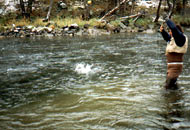|
Bigfoot Campground
|
Fly Fishing The Trinity River
When targeting Steelhead on the fly, the Trinity River is one of the best for having strong returns of adult wild and hatchery fish over a long season. Traditional methods of swinging flys to unsuspecting fish can be exciting when stream conditions allow for effective presentations, reaching fish holding in changing depths and currents will test angler skills and endurance. Knowledge of holding waters, depth, speed of current, line manipulation with working patterns, will help lead to successful grabs. Rods in the 5 to 8 weight range are preferred with weight forward floating lines. Nymphing techniques will dominate most of the better action with long leaders and weighted flys fished with methods that enable the fly to be on or near the bottom as often as possible will reward anglers with more consistence. Adult Steelhead are the focus for action from the mid to upper Trinity with one year salt (half-pound Steelhead) being found predominately on the lower portions of the Trinity.
Advantages of using a floating line are the ease in which you can switch from Nymphing to swinging a fly. With line handling being at the easiest to perform tighter loops for increased distance and roll casts to avoid those brushy banks. Fatigue is reduced by not having to pull the sinking line out of the water and the inconvenience of changing spools.
Dead Drift Nymphing is one of the most effective techniques used for covering the different depths and currents. A weight forward floating line is preferred attached to a tapered leader of 7 to 12 feet with a tippet size larger than the terminal leader material to be used. The terminal leader is tied using a surgeon or blood knot, the length is determined by the depth of the water to be fished, total length should be one and a half times the depth of the water. The single or double fly set up is attached with lead shot 18 in. or more above the offering. An adjustable strike indicator offers several advantages, easier visual detection of a fishes grab and the sporadic ticking of the bottom.This makes a fast easy adjustment to control the leader length and suspend presentations on or near the bottom where fish often feed. Easy to learn and usually takes 10 to 20 minutes of instruction to get the hang of it.
What to bring:
Comfortable wading gear, chest high neoprene waders, felt soles. Wading
belt.
Warm clothing for cold and sometimes wet conditions.
Provided:
The use of rods and reels. All tackle. leader materials, flys.
Boat heater with 28,000 BTU can really be user friendly on cold days.
